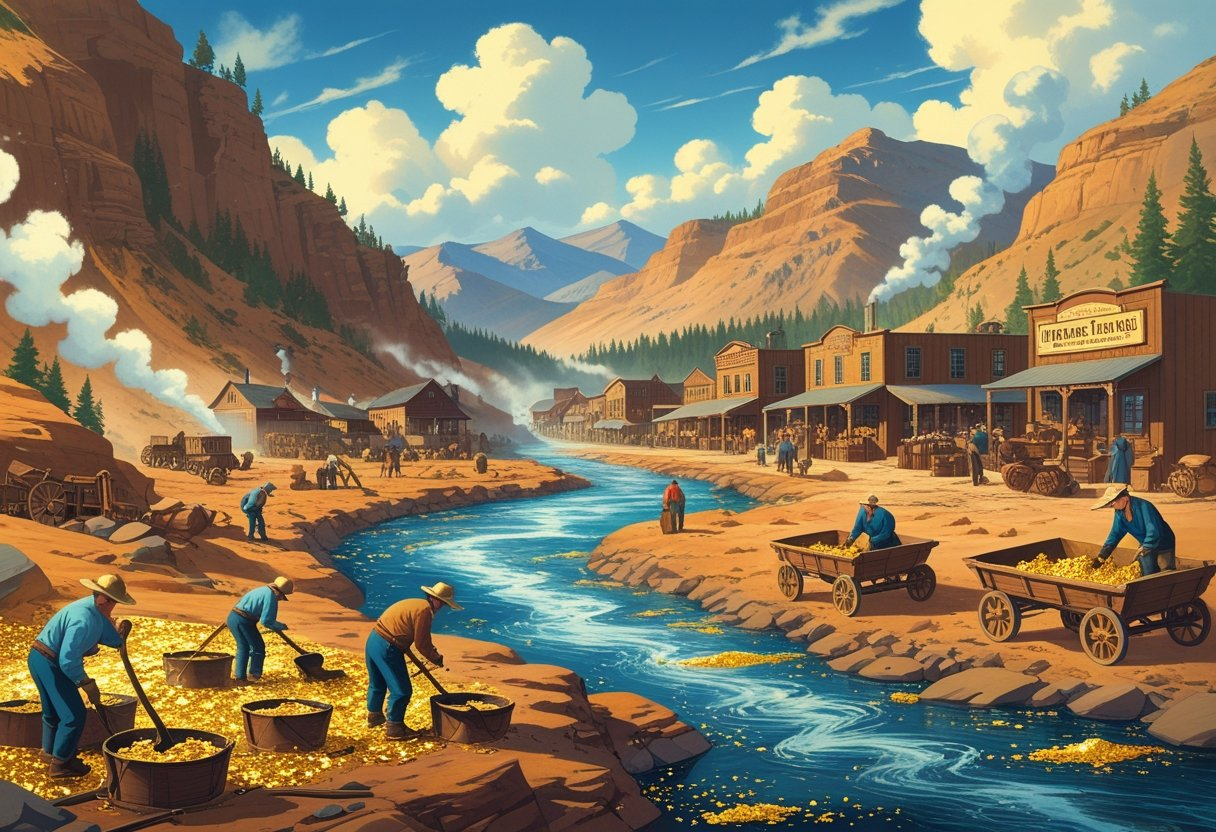The California Gold Rush triggered one of the most important economic changes in U.S. history. It attracted hundreds of thousands of people seeking wealth, which rapidly grew California’s population and led to the establishment of new towns and businesses.

The influx of gold increased the money supply, causing inflation but also stimulating demand for goods and services across the region. New industries, like mining equipment, clothing, and food production, boomed to meet the needs of prospectors and settlers.
Businesses such as Wells Fargo and Levi Strauss began during this era. The Gold Rush spurred entrepreneurship and lasting economic growth.
At the same time, the Gold Rush sparked major changes beyond California. It hastened U.S. westward expansion and influenced global trade by creating new markets for foreign goods.
The rapid development of infrastructure, like roads and railroads, connected California to the rest of the country. This helped integrate the West into the national economy.
Discovery and Origins of the Gold Rush

The California Gold Rush began with a gold discovery that sparked a massive migration and economic change in mid-19th century America. The event took place shortly after significant political shifts in the region, setting the stage for California’s rapid development.
James W. Marshall and Sutter’s Mill
In January 1848, James W. Marshall, a carpenter working for John Sutter, found flecks of gold near the American River while building a sawmill. Marshall tested the samples by biting and striking them with a hammer, confirming they were real gold.
John Sutter, owner of the land and the mill project, tried to keep the discovery secret, fearing the rush of miners would disrupt his plans. However, news spread quickly.
Within months, thousands of people from across the U.S. and other countries flocked to the area, hoping to find fortune.
Contributing Factors to the Gold Rush
Several factors helped turn Marshall’s discovery into a massive gold rush. The timing was crucial, as America was experiencing rapid population growth and industrial expansion.
News of gold traveled fast due to newspapers and improved communication. Transportation improvements like steamships and stagecoaches made California more accessible.
Many people were motivated by the promise of wealth and adventure. The rush created booming towns and increased demand for goods and services beyond just mining.
Mexican-American War and Territorial Changes
The Gold Rush happened shortly after the Mexican-American War ended in 1848. By the Treaty of Guadalupe Hidalgo, Mexico ceded California and other western lands to the U.S.
This transfer opened up these territories for American settlement and development. Before the Gold Rush, California was a remote, lightly populated region.
The U.S. government’s control and the sudden influx of migrants helped California quickly change from a territory to a state by 1850. This political change was essential in supporting the rapid growth caused by the rush.
Population Movements and Demographic Change

The Gold Rush triggered rapid and large-scale population shifts that reshaped California’s society. It brought thousands of people from across the United States and around the world.
These movements changed the ethnic mix, social structures, and the balance of local power.
Mass Migration and the Forty-Niners
The term “Forty-Niners” refers to the roughly 100,000 prospectors who arrived in California in 1849. Most came by sea or overland trails, drawn by news of gold discoveries.
This sudden influx caused towns like San Francisco to explode in size within months. Migration was mostly young men hoping to strike it rich.
Many worked as miners, but others opened businesses to support the growing communities. This large-scale movement fueled California’s fast economic growth.
International Migration Patterns
The Gold Rush attracted not only Americans but also immigrants worldwide. People came from China, Latin America, Europe, and Australia.
Each group contributed labor and skills, shaping California into a diverse region. Chinese immigrants often worked as miners or laborers under difficult conditions.
Latin Americans, including Mexicans and Chileans, also played key roles in mining and local trade. This diversity set California apart, although ethnic tensions sometimes arose due to competition and cultural differences.
Role of Native Americans
Native American populations experienced significant disruption due to the Gold Rush. As prospectors moved west, they encroached on indigenous lands and resources.
This caused displacement, loss of hunting grounds, and violent conflicts. Many tribes suffered from disease, starvation, and violence during this period.
Their traditional ways of life were deeply affected by the rapid influx of settlers and changes in land ownership. The Gold Rush accelerated the decline of some Native American communities in California.
Economic Transformations and Growth
The Gold Rush reshaped the economy by creating new markets, expanding industries, and establishing financial institutions that supported rapid development. It fueled commerce in growing mining towns and sparked investments in mining tools and services.
Boom in Trade and Commerce
The sudden population growth in gold mining areas drove demand for a wide variety of goods. Merchants supplied food, clothing, tools, and other essentials, often at high prices due to scarcity.
Trade routes expanded quickly to meet these needs. Wagons and ships brought supplies from the East Coast and overseas.
The rise of urban centers like San Francisco enabled complex trade networks between mining towns and larger markets. Commercial activity surged as businesses flourished, from general stores to saloons.
Mining Equipment and Related Industries
The demand for mining tools and supplies led to growth in manufacturing and service industries linked to gold mining. Companies produced picks, shovels, pans, and later more advanced equipment like sluice boxes and hydraulic machinery.
Supporting industries included transportation, construction, and food production. The need to build roads, bridges, and shelters created jobs and opportunities outside mining itself.
These industries developed alongside the mining towns, forming diverse local economies that offered more than just mining jobs.
Banking and Financial Institutions
The inflow of gold required secure ways to store and transfer wealth, prompting the establishment of banks and financial services in mining regions. These institutions provided loans and credit to miners and entrepreneurs.
Banks helped convert mined gold into currency, supporting wider economic activity. They also funded infrastructure projects, including transportation systems necessary for trade.
The rise of these financial systems contributed to broader economic transformations, linking local markets to national and international economies.
Infrastructure and Technological Progress
The Gold Rush required massive improvements in transportation and communication to support the growing population and economy. This demand accelerated the build-out of railroads, steamship routes, and telegraph systems.
These advancements helped connect the West with the rest of the country. Travel and information exchange became faster and more reliable.
Expansion of Railroads
The Gold Rush spurred the rapid expansion of railroads, especially the push for a transcontinental railroad. Completed in 1869, this railroad linked California to the eastern United States, cutting travel time from months to days.
The Central Pacific Railroad worked westward from Sacramento, while the Union Pacific Railroad built eastward from Omaha. Railroads carried miners, supplies, and gold, enabling faster and safer movement than wagons or horses.
The project employed thousands, including many Chinese laborers who worked under harsh conditions. Railroads also opened new settlements and markets, supporting agriculture and industry beyond mining.
Steamships and Transportation
Steamships played a crucial role in Gold Rush transportation. Ships carried people and goods along the Pacific coast and between coasts via Panama.
This route was faster and safer than traveling overland across difficult terrain. Steamship lines increased commerce by delivering mining equipment, food, and mail to remote areas.
Ports like San Francisco grew rapidly as key hubs for steamship traffic. These vessels also made it easier for immigrants to reach the goldfields.
Telegraph and Communication
The demand for quick information during the Gold Rush led to the development of the telegraph system. The first transcontinental telegraph, completed in 1861, connected California with the East Coast.
This allowed instant communication about gold discoveries, business deals, and news. Telegraph lines were essential for coordinating railroad schedules and managing mining operations.
Newspapers in boomtowns relied on telegraph services to share updates. This helped settlers stay informed and connected.
Societal Impact and Social Equity
The Gold Rush reshaped social life in mining regions, creating new communities and fueling conflicts over rights and resources. It affected different groups unevenly, often deepening existing inequalities.
Laws and social practices reflected these tensions, impacting immigrants and native populations alike.
Formation of Mining Camps and Communities
Mining camps quickly grew into towns as people sought fortune. These settlements were often makeshift, with tents and wooden shacks.
Over time, camps developed basic infrastructure like shops, saloons, and schools to serve a diverse population. Communities formed around mining claims, sometimes governed by informal rules or mining codes.
These local regulations aimed to manage land use and resolve disputes but varied widely. Mining towns attracted people from many countries, creating a mix of cultures but also challenges in social cohesion.
The rapid urban growth led to overcrowding and poor sanitation. Housing was scarce and costly, often forcing residents into cramped conditions.
Despite this, mining towns became vibrant centers of trade and social life.
Social Inequalities and Racial Tensions
The Gold Rush amplified social inequalities and racial conflicts. White miners often held political and economic power, while minorities faced discrimination and exclusion.
Native Americans were pushed off their lands and suffered greatly from the influx of settlers. Chinese immigrants, who arrived in large numbers, endured harsh working conditions and unequal treatment.
They were often restricted to low-paying jobs and faced violent hostility. This discrimination extended to other groups, such as Latin Americans and African Americans.
Racial tension sometimes erupted into violence. Miners and townspeople created exclusionary organizations and policies to limit non-white participation.
These tensions reflected broader social attitudes and complicated efforts for equal rights within mining communities.
Foreign Miners’ Tax
The Foreign Miners’ Tax was a law that required non-American miners to pay fees to mine. Aimed mainly at excluding Latin American and Chinese miners, the tax was a form of economic discrimination.
It forced many foreigners to abandon claims or work illegally. Collected fees were high and hard to pay, limiting opportunities for immigrant miners.
Enforcement was inconsistent but often brutal. The tax fueled resentment and deepened divides in mining society.
The law also reflected broader tensions over land and resources. It made clear that economic benefits were not shared equally and that some groups were systematically disadvantaged during the Gold Rush era.
Environmental and Cultural Legacy
The Gold Rush had lasting effects on both the environment and the cultures involved. Mining practices caused significant changes to natural landscapes and ecosystems, while the rush also reshaped societal structures and cultural identities in affected regions.
Hydraulic Mining and Environmental Impact
Hydraulic mining was a common technique during the Gold Rush that used powerful water jets to break apart hillsides and riverbeds. This method caused severe erosion and stripped away large areas of vegetation.
The displaced soil and rock clogged rivers, leading to flooding and the destruction of fish habitats. Mercury and other chemicals used in gold extraction polluted waterways, affecting wildlife and human health.
Many landscapes still show scars from hydraulic mining. Efforts to restore these areas have been expensive and difficult due to the scale of damage.
Long-Term Sustainability Challenges
The environmental damage from the Gold Rush created ongoing challenges for sustainability. Once mining stopped, many areas were left with eroded land, contaminated water, and dead forests.
Rehabilitation has been slow because of the chemicals used and the vast changes to ecosystems. Some polluted sites continue to harm plants and animals decades after mining ceased.
Sustainability in mining today emphasizes reducing environmental harm. Lessons from the Gold Rush show the pitfalls of rapid, unchecked resource extraction.
Cultural Legacy of the Gold Rush
The Gold Rush brought together diverse groups of people, including immigrants and indigenous populations. This mixing created multicultural communities but also caused displacement and conflicts.
Indigenous lands were often taken. This disrupted traditional ways of life.
Social inequalities, such as discrimination against Chinese and other non-European miners, were common.



